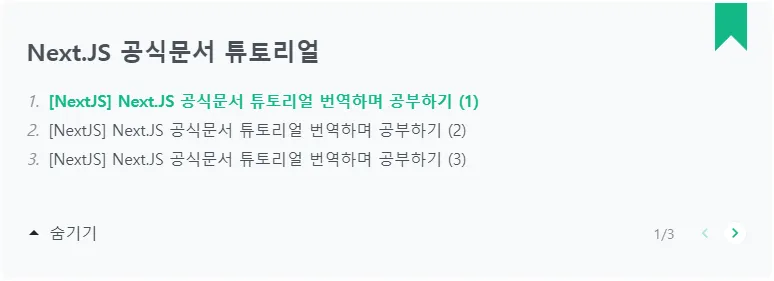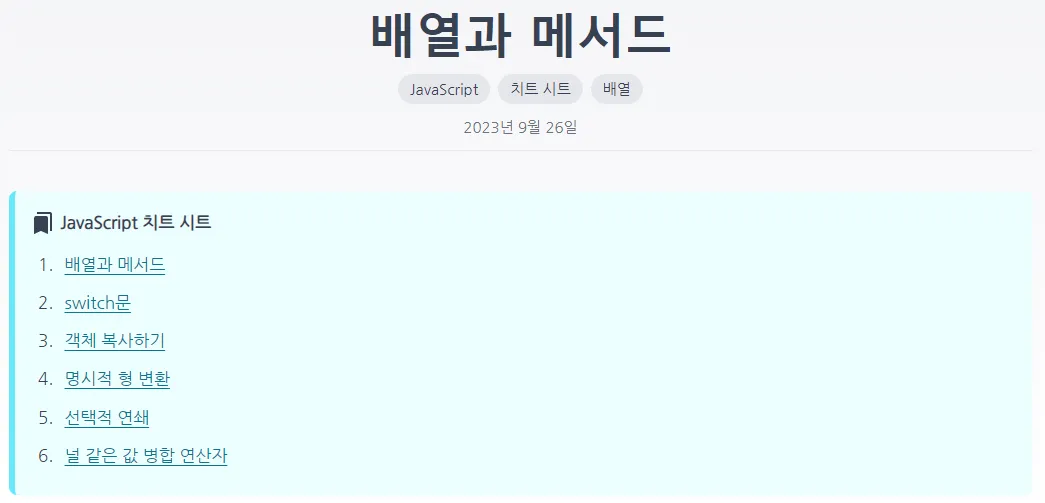Astro 블로그에 시리즈 기능 추가하기
Astro 기반 블로그에서 Astro의 컨텐츠 컬렉션을 이용하여 시리즈 기능을 추가했던 과정을 소개한다.
시리즈 기능이란?
다음은 개발 블로그로 많이 사용하는 velog에서 볼 수 있는 시리즈 기능이다.

어떤 주제에 해당하는 일련의 포스트들이 나열된 것을 볼 수 있다. 시리즈는 하나의 포스트에 담기에는 글이 너무 길고 여러 포스트로 나누고 싶을 때 유용하다.
시리즈 기능을 정의하자면, 여러 포스트를 하나의 순서로 묶는 것이다. 이를 좀 더 구체적으로 설명하면 다음과 같다.
- 시리즈에는 제목과 포스트 목록이 포함된다.
- 각 포스트는 자신이 속한 시리즈를 알아야 한다.
관계형 DB를 설계하는 문제와 비슷하게 보인다. 시리즈와 포스트의 관계를 설정해야 하기 때문이다.
구현 방법은 각 포스트가 시리즈 데이터를 갖는 방식과 시리즈를 하나의 콘텐츠 컬렉션에 모아 두는 방식이 있을 것이다. 후자의 방식이 관심사가 분리되고 시리즈 확장이 쉬워진다.
구현
먼저 전체 스키마를 다음과 같이 정의한다.
import { defineCollection, reference, z } from 'astro:content';
const blog = defineCollection({ schema: z.object({ title: z.string(), description: z.string(), }),});
const series = defineCollection({ type: 'data', schema: z.object({ title: z.string(), posts: z.array(reference('blog')), }),});
export const collections = { blog, series };시리즈의 posts가 reference('blog')의 배열로 정의된 것을 주목하자. reference('blog')는 포스트 컬렉션을 참조한다는 것을 의미한다. 따라서 z.array(reference('blog'))는 여러 개의 포스트 참조로 해석할 수 있다.
시리즈 파일은 json이나 yaml 포맷을 사용할 수 있는데, 나는 yaml을 사용하였다.
title: 나의 멋진 시리즈posts: - my-awesome-post-1 - my-awesome-post-2 - my-awesome-post-3 - my-awesome-post-4 - my-awesome-post-5이제 포스트 페이지에서 프롭으로 시리즈를 전달한다.
---import { getCollection, type CollectionEntry } from 'astro:content';import PostLayout from 'layouts/post.astro';
export async function getStaticPaths() { const posts = await getCollection('blog'); const serieses = await getCollection('series');
return posts.map((post) => { const foundSeries = serieses.find((series) => series.data.posts.some((seriesPost) => seriesPost.slug === post.slug), );
return { params: { slug: post.data.title }, props: { post: post, series: foundSeries, }, }; });}
const { post, series } = Astro.props;const { Content } = await post.render();
interface Props { post: CollectionEntry<'blog'>; series: CollectionEntry<'series'> | undefined;}---
<PostLayout postData={structuredClone(post.data)} seriesData={structuredClone(series?.data)}> <Content /></PostLayout>seriesData는 프롭 드릴링을 통해 시리즈를 표시하는 컴포넌트까지 전달된다. 전달된 seriesData의 posts에는 앞서 말했듯이 포스트 참조의 배열이 들어 있다. 이 참조 배열을 getEntries와 같이 사용하면 실제 컨텐츠를 가져올 수 있다.
---import { getEntries, type CollectionEntry } from 'astro:content';
const { seriesData } = Astro.props;const seriesPosts = await getEntries(seriesData.posts);
interface Props { seriesData: CollectionEntry<'series'>['data'];}---
<ol> { seriesPosts.map((seriesPost) => ( <li> <a href={'/blog/' + seriesPost.data.title}>{seriesPost.data.title}</a> </li> )) }</ol>실제 구현 과정이 궁금하다면 PR에서 확인할 수 있다.
결과
내 블로그에서 실제로 사용하는 모습은 다음과 같다.

로직은 거의 비슷하며 스타일만 입혔을 뿐이다.
추가 기능
추가적으로 구현할 만한 기능은 다음과 같다.
- 중첩 시리즈: 시리즈 내부에 시리즈를 넣을 수 있다.
- 유효성 검사: 포스트가 하나의 시리즈에만 속하는지 확인한다.